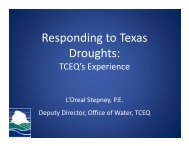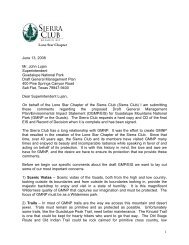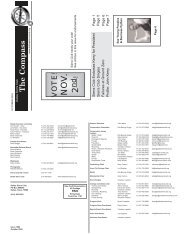Fall 2002 - Lone Star Chapter, Sierra Club
Fall 2002 - Lone Star Chapter, Sierra Club
Fall 2002 - Lone Star Chapter, Sierra Club
You also want an ePaper? Increase the reach of your titles
YUMPU automatically turns print PDFs into web optimized ePapers that Google loves.
<strong>Lone</strong> <strong>Star</strong> <strong>Sierra</strong>n <strong>Fall</strong> <strong>2002</strong> 3<br />
Feature<br />
Citizens Rally to Oppose<br />
the Proposed Marvin Nichols Reservoir<br />
Diverse Coalition Pushes Conservation over Development<br />
By Ken Kramer, Director, <strong>Lone</strong> <strong>Star</strong> <strong>Chapter</strong><br />
“Meet the faces of a new coalition,”<br />
said Rita Beving, conservation<br />
co-chair of the Dallas Regional<br />
Group of the <strong>Sierra</strong> <strong>Club</strong>, as<br />
she stood and spoke on July 22 to<br />
a rally of 150 people from North<br />
Central and Northeast Texas<br />
united to show their opposition to<br />
the proposed Marvin<br />
Nichols Reservoir.<br />
“They are loggers,<br />
farmers, ranchers,<br />
and private landowners…from<br />
Dalby<br />
Springs to Dallas,<br />
from Denton to<br />
Texarkana…in all<br />
my years as an<br />
activist I have<br />
never seen such<br />
dedication from a<br />
group united for a<br />
single cause,” added<br />
Beving.<br />
Indeed it was an<br />
impressive sight.<br />
Over 50 people had<br />
come by bus from<br />
Northeast Texas to Grand Prairie<br />
to join with 100 citizens from the<br />
Metroplex to attend a meeting of<br />
the Region C Water Planning<br />
Group, the water planning group<br />
for the region that includes the<br />
Dallas/Forth Worth metropolitan<br />
area. These somewhat unlikely<br />
allies were there to promote water<br />
conservation over water development,<br />
to argue for saving the<br />
taxpayers’ money as well as saving<br />
water.<br />
The Proposed Reservoir<br />
The immediate target of their<br />
passion was the proposed Marvin<br />
Nichols Reservoir. The reservoir,<br />
which is included in the current<br />
regional water plans for both<br />
Regions C and D, would be located<br />
in Region D (Northeast Texas) in<br />
the Sulphur River Basin.<br />
Although the reservoir is proposed<br />
to be located in Northeast Texas,<br />
80 percent of the water from the<br />
reservoir would be transferred by<br />
Citizens opposing the Marvin Nichols Reservoir vow “No Nickles for Nichols.”<br />
pipeline to the Dallas/Fort Worth<br />
region. Water customers in that<br />
region would be the ones primarily<br />
responsible for the $1.7 billion<br />
price tag for the project.<br />
The proposed reservoir project<br />
would be a large one by any standard.<br />
It would inundate about<br />
72,000 acres of forests, ranchland,<br />
and farmland along the Sulphur<br />
River in Red River, Bowie,<br />
Franklin, Titus, and Morris counties.<br />
The reservoir would yield<br />
619,100 acre feet of water per<br />
year. (An acre foot of water is the<br />
amount of water needed to flood<br />
one acre of land to a depth of one<br />
foot – it is equivalent to approximately<br />
325,000 gallons of water).<br />
The water from the reservoir<br />
going to the Dallas/Fort Worth<br />
region would travel in a pipeline<br />
about 170 miles long.<br />
The project would be built and<br />
managed by the Sulphur Basin<br />
River Authority (SBRA), a regional<br />
water authority created by the<br />
Texas Legislature<br />
in 1985. SBRA<br />
has the authority<br />
to control, store,<br />
conserve, and<br />
distribute surface<br />
water in the<br />
Sulphur River<br />
basin consistent<br />
with surface<br />
water rights<br />
granted by the<br />
State of Texas to<br />
varied water<br />
users in the<br />
basin. SBRA has<br />
contracted with<br />
two Texas engineering<br />
firms for<br />
studies of the<br />
feasibility of the reservoir.<br />
In its regional water plan,<br />
however, the Region D Water<br />
Planning Group did not identify<br />
any unmet water needs in its own<br />
region within the next 50 years.<br />
Thus, water from the Marvin<br />
Nichols Reservoir would primarily<br />
benefit only Region C for the<br />
foreseeable future, although some<br />
of the water in the reservoir would<br />
be available for Northeast Texas in<br />
the distant future.<br />
Photo courtesy of Justin Murrill<br />
The Opposition<br />
The citizens from Northeast<br />
Texas who oppose the reservoir do<br />
Continued next page







